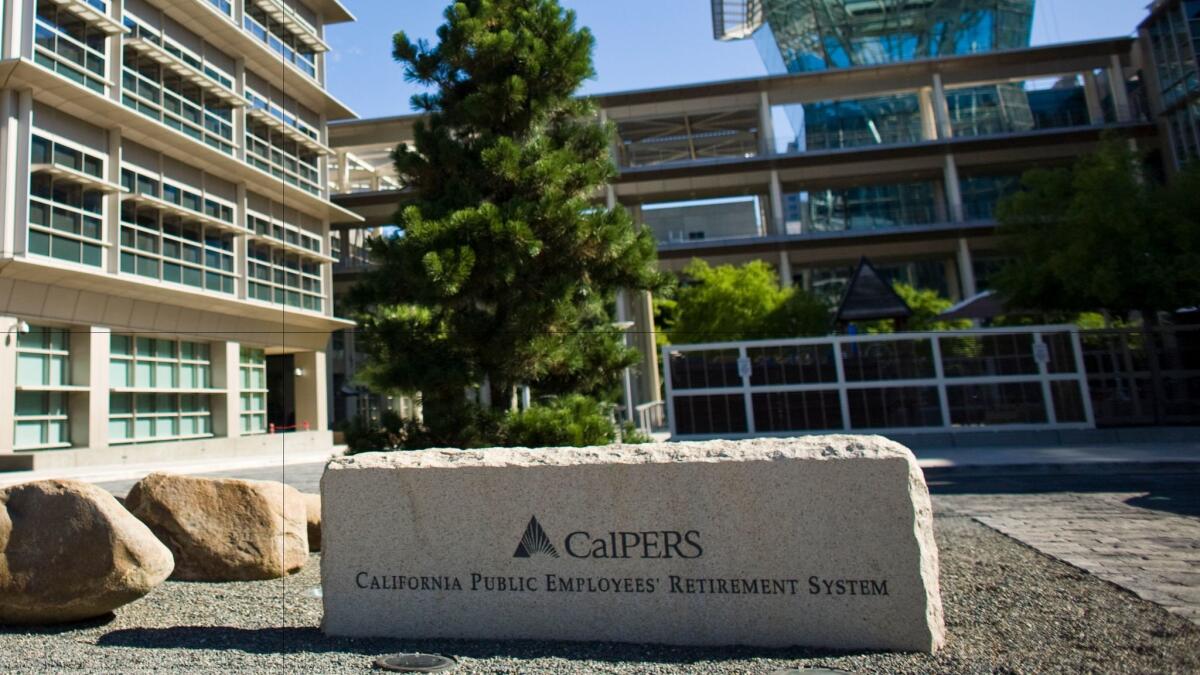Editorial: CalPERS takes one costly step back toward reality

- Share via
One year ago, the California Public Employees’ Retirement System board cautiously moved to shore up its $300 billion pension fund in the face of dwindling returns on its investments. It agreed to lower the amount it expected those investments to earn, which in turn would force the employers in CalPERS — more than 3,000 state and local agencies and school districts — and many of their workers to pay more into the fund each year. But the board decided those adjustments would be made only in years when CalPERS recorded prodigious returns, spreading the potential pain out over two decades.
That policy allowed the board to cling to its projection of 7.5% growth in its investments and hold down employer and worker contributions until the market boomed again. But then, another year of lousy returns — less than 1% in 2015-16, on the heels of only 2.4% the prior year — pushed the fund more deeply into the hole, and the CalPERS board woke up to the failings of last year’s plan. It agreed Wednesday to lower expected investment earnings to 7% over the next three years.
It’s about time. Magical thinking about investment earnings only delays the inevitable demand by CalPERS for higher contributions from governments and workers, and in doing so, makes the fix more expensive. Like a savings account in reverse, the shortfalls grow each year the fund doesn’t out-perform its expectations enough to compensate for the prior loss in anticipated earnings. The higher those expectations are, the harder it is for the fund to catch up — and the more governments and employees eventually will have to pay to shore up public employee pensions.
Resetting the expected investment earnings may be the right thing to do, but the cost to public employers will be significant. By 2024, Gov. Jerry Brown has estimated, state agencies alone will be spending $2 billion more per year on pensions, an increase of almost 40%. The state can absorb that kind of hit; local governments and school boards with far smaller tax bases may not be so well-equipped. At least some will be forced to take drastic steps to increase revenue or cut costs — for example, by laying off workers and rolling back services. Meanwhile, recently hired workers will automatically be required to pay more into the pension fund; for the rest, cities and school boards are likely to demand higher contributions at the bargaining table.
Defenders of the high rate of projected earnings often have pointed to the superior performance of CalPERS’ investments in the decades leading up to this century. But over the last 20 years, the fund has earned less than 7% per year on average. And given the trends in U.S. productivity and GDP growth, even 7% annual earnings seems unrealistic. A high rate also forces CalPERS to make riskier investments in search of outsize returns, which is fine — until they don’t pay off.
The coming years could be rough on state and local finances. Several tax-reform ideas floated by the incoming administration and congressional Republicans could raise the cost of borrowing dramatically, on top of the Federal Reserve’s pushing interest rates higher. Nevertheless, pensions are a promise governments shouldn’t (and cannot, except possibly through bankruptcy) break. It’s far better to be realistic about their costs now than to pay a considerably higher bill later.
More to Read
A cure for the common opinion
Get thought-provoking perspectives with our weekly newsletter.
You may occasionally receive promotional content from the Los Angeles Times.










